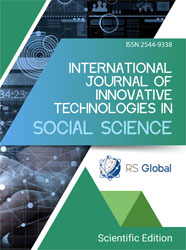ANALYSIS OF THE CURRENT STATUS OF THE POLICE ORGANIZATION’S ROLE IN ENSURING ECONOMIC SECURITY
Abstract
Economic security encompasses a nation's economic stability, independence, and safeguarding against external influences. The Mongolian Police have been actively engaged in activities aimed at maintaining national security, preventing crime, preserving public order, and ensuring public safety.
While the police is fulfilling their legal responsibilities to uphold economic security, there is a lack of coordination among organizations, as well as a shortage of skilled personnel, advanced technology, and equipment. Therefore, it is imperative to assess the current role of the police in economic security and explore ways to enhance their involvement in safeguarding economic interests.
This study investigates the current role of Mongolia's police organization in safeguarding economic security, focusing on combating financial crimes and money laundering. By analyzing seven years of crime data (2017-2023) and using SWOT methodology, the research highlights significant challenges in law enforcement's ability to effectively address economic threats.
The SWOT analysis identifies organizational strengths such as experienced personnel and established monitoring systems, but also highlights critical weaknesses in technological infrastructure, human resource capacity, and inter-agency coordination. External opportunities for improvement include international cooperation and legal framework enhancements, while threats stem from evolving criminal tactics, technological advancements by perpetrators, and political interference.
In conclusion, the study emphasizes that despite active involvement in economic security initiatives, Mongolia's police encounter significant challenges in personnel training, technological resources, and organizational coordination. To effectively combat sophisticated economic crimes and safeguard national economic interests, enhanced international collaboration, modernized investigative tools, improved legal frameworks, and strengthened inter-agency cooperation are essential.
References
Altansukh, N., & Urjin, O. (2025). Economic security, police involvement, international experiences, and country comparisons. International Journal of Innovative Technologies in Social Science, 1(45). https://doi.org/10.31435/ijitss.1(45).2025.3175
College of Policing. (2015, February 27). Neighborhood watch: Impact and effectiveness. https://www.college.police.uk/research/crime-reduction-toolkit/neighbourhood-watch
FBI seeks crypto industry help to track, block laundering of Bybit hack funds. (2025, February 27). How the FBI Is Using Bitcoin Tracking to Fight Crime, Coin Desk. https://www.coindesk.com/policy/2025/02/27/fbi-seeks-crypto-industry-help-to-track-block-laundering-of-bybit-hack-funds
Asia/Pacific Group on Money Laundering. (2017). Anti-money laundering and counter-terrorist financing measures: Mongolia - Mutual evaluation report. Financial Action Task Force. https://www.fatf-gafi.org/en/publications/Mutualevaluations/Mer-mongolia-2017.html
Fox-Brewster, T. (2018, February 26). Cellebrite: The Startup That Can Unlock Any Phone. https://www.forbes.com/sites/thomasbrewster/2018/02/26/government-can-unlock-iphone-x-8-plus-cellebrite/
General Directorate of the Police, Information Analysis and Rapid Response Service. (2017-2023). Statistics [Dataset]. Ministry of Justice and Home Affairs.
Haaretz. (2024, April 16). How Israel's security forces work together to keep the country safe. https://www.haaretz.com
Great Khural of Mongolia. (2010, July 15). Resolution No. 48 of 2010 on the concept of national security of Mongolia. Parliament of Mongolia.
Next gov. (2024, April 9). How the FBI uses artificial intelligence to investigate crimes? https://www.nextgov.com/emerging-tech/2024/04/how-fbi-uses-artificial-intelligence-investigate-crimes/396725/
The Wall Street Journal. (2023). FBI's use of Palantir tools raises privacy concerns. https://www.wsj.com
Views:
35
Downloads:
33
Copyright (c) 2025 Altansukh Norov

This work is licensed under a Creative Commons Attribution 4.0 International License.
All articles are published in open-access and licensed under a Creative Commons Attribution 4.0 International License (CC BY 4.0). Hence, authors retain copyright to the content of the articles.
CC BY 4.0 License allows content to be copied, adapted, displayed, distributed, re-published or otherwise re-used for any purpose including for adaptation and commercial use provided the content is attributed.











